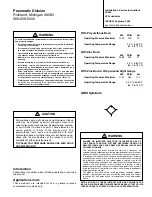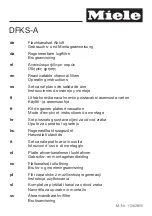
Page 7 of 12
RO-300G & RO-600G
W A T E R P U R I F I C A T I O N S Y S T E M
Operation and Maintenance
VI. OPERATION AND MAINTENANCE:
Your water purifier has filter cartridges (Sediment and
Activated Carbon Block) which must be replaced every
year as part of regular maintenance to ensure proper
operation, the membrane may last up to two years but
there are exceptions depending on the quality of the feed
water it may be required to make these changes more
frequently also for cartridges.
NOTE: It is recommended when you change cartridges also to perform a system
sanitation, to thereby counteract any existing microbiological contamination.
How to change filter cartridges and perform
a system sanitation:
1. Close the tap water supply and disconnect the system
from the electrical outlet.
2. Open the key storage tank outlet (only when sanitizing).
3. Open the faucet
t
o depressurize the system.
4. Loosen up the filter housings with a plastic wrench.
One by one, remove the cartridges and wash the housing’s
interior with a mild soap and rinse.
5. To remove the RO membrane, disconnect the tubing that
feeds the input of RO housing (feed, product and rejection)
to loosen the cap threated. Remove the membrane and
wash inside the housing with mild soap and rinse.
Place the filter and membrane housings to its original position
and add 2 table spoons of 6% commercial bleach only in
the first Pre-Filter. Make sure to tighten all the housings and
slowly open up the feed valve to allow the chlorine water to
fill the entrire system that in this step is without cartridges and
membrane. Allow the system to expelled all the air out thru the
faucet and then close it.
Allow to sit a minimum of at least 30 minutes and then let the
water flow until all the chlorine solution is released. At least let
the water run for five minutes and then check that there is no
presence of chlorine in the water with a chlorine kid. Once this
rinsing process is completed, close again the water feed valve.
Reemplace the cartridges and membrane and make sure the
filter and membrane housings are tighten up. Remember to
move the exterior oring towards the side of the cap of the
membrane housing. Tighten with the plastic wrench included.
Return to its original position any connector and tubing that
was removed.
To return operation to your system, slowly open the water
feed to allow the pre-filters to be fill before connecting to the
electrical outlet. Then follow steps in Start up section.
The reverse osmosis process causes the concentration
of impurities. The impurities may precipitate when their
concentration reaches saturation levels.
NOTE: The precipitation may foul the membranes must be prevented.
1. Periodically observe the quality and quantity of product
water from the system.
NOTE: Check the feedwater pressure going to the reverse osmosis membrane,
a significant pressure drop may indicate that pre-filters are dirty.
2. A 20% increase in TDS when checking the permeate water
indicates possible membrane damage, and the membrane
may need to be replaced.
3. It is suggested that a hand held TDS digital meter is used
once per week to monitor the water quality.
Note: If the TDS of the feed water exceeds 1000 ppm, a larger flow restrictor
should be used to extend the membrane life.
4. It is important to maintain and/or replace the carbon block
regularly RO membranes are chlorine sensitive. Irreversible
damage will occur with any chlorine present in the feed water.
5. The product line has a one way check valve installed. The
check valve should be checked regularly and replaced if it is
not properly sealing.
6. Keep the feed water temperature above 4 °C (36 °F).
Note: Extremely cold feed water will lower the product water output and
increase pump pressure.
RO-300G-600G_manual.indd 7
6/28/16 3:57 PM






























